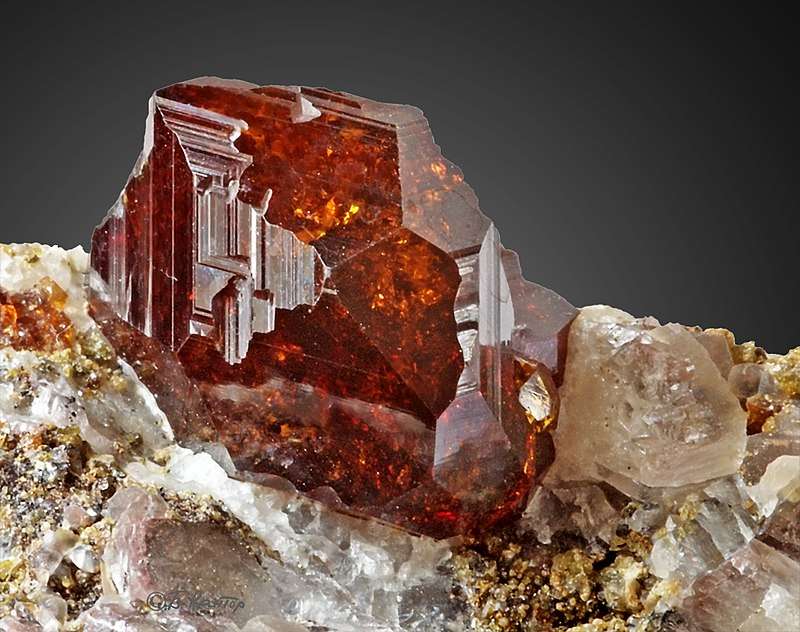
Appearance
A wide range of hues, including red, green, orange, yellow, brown, pink, and even colorless, are found in garnets. The kind and quantity of elements contained in the crystal lattice dictate the particular color. The vitreous (glassy) luster that garnets usually have when polished adds to their brilliance. There are two types of garnets: translucent and transparent. While some garnet variants, like andradite, can be more translucent, others, like almandine and pyrope, tend to be more transparent.
Geographical Distribution
Around the world, garnets are found in many places; some noteworthy places are Madagascar, India, the United States, Africa, Brazil, Sri Lanka, Australia, and Scandinavia.
History
More than 5000 years ago, during the Bronze Age, garnet first appeared on record. Because the tiny, red crystals were believed to resemble pomegranate seeds, the name of this ancient plant was taken from the Latin word granatium, which means pomegranate.
Metaphysical Properties
It brings calmness or passion depending on the situation. It revitalizes, purifies, and balances energy. Encourages fidelity and love. Garnet eases emotional discord and balances sex drive.

Chemical Composition
The standard chemical formula of garnets is A 3B 2Si 3O 12, where B is a trivalent cation (Fe 3+, Al 3+, Cr 3+) and A is a divalent cation (Fe 2+, Ca 2+, Mg 2+, and Mn 2+).
Types
The following are a few of the most popular varieties of garnets:
Almandine:
Almandine garnets have a high refractive index, which gives them good brilliance, and are usually red to reddish-brown in color. These are some of the most popular and well-known types of garnet. Metamorphic rocks are frequently home to almandine garnets.
Pyrope:
Usually having a rich red color, pyrope garnets can also have a purplish tint. They are renowned for their vibrant color and have a high refractive index. Pyrope garnets are well-known for their use as gemstones and are frequently found in igneous and metamorphic rocks.
Spessartine:
Because of their vivid orange hue, spessartine garnets—which can range in color from orange to reddish-brown—are frequently referred to as “mandarin garnets. When compared to other garnets, they have a comparatively lower refractive index. Pegmatites and metamorphic rocks are usually where one can find spotted garnets.
Grossular:
Colors of grossular garnets range from green to yellow to brown to even colorless. Tavorite is one of the most well-known green grossular garnets. Large-grained garnets are frequently found in metamorphic rocks and are connected to deposits of skarn.
Andradite:
Garnets of andradite can be green, yellow, brown, or black in color. The demantoid variant, which is green, is renowned for its high dispersion and brightness. Metamorphic and skarn deposits are common places to find andradite garnets.
Uses
- Gemstone: Gemstones are among the most well-known applications for garnet. A variety of garnet varieties, including spessartine, pyrope, and almandine, are prized for their vivid hues and brilliance. Since ancient times, red garnets have been widely used for jewelry. They are frequently utilized in necklaces, earrings, rings, and other kinds of jewelry.
- Industrial Abrasives: Because of its long lifespan and hardness, garnet is a great material for industrial abrasives. It is utilized in sandpaper, waterjet cutting, and abrasive blasting. Because they can precisely manage cutting operations and cut through hard materials with minimal dust production, garnet abrasives are preferred.
- Water Filtration: Particularly in multi-media filters, garnet is utilized in water filtration systems. Sediment, trash, and suspended particles are effectively removed from water with its high specific gravity and sharp edges. It works well as a filtration medium for home and commercial water treatment applications.
- Lapidary and Carvings: In addition to being used as gemstones, garnets are carved into complex patterns and sculptures by lapidaries and artists. Certain garnet varieties are transparent and have distinctive color variations that make them ideal for artistic creations.
- Metallurgical Applications: Garnet finds application in metallurgical procedures including metal industry abrasive blasting and waterjet cutting. It aids in shaping, cleaning, and readying metal surfaces for a range of uses.
Table





